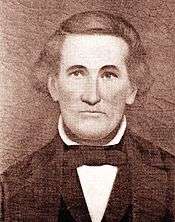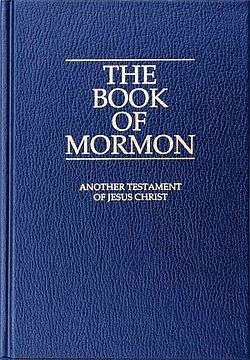Eight Witnesses
The Eight Witnesses were one of the two groups of witnesses who made a statement stating that they had seen the golden plates which Joseph Smith said was his source material for the Book of Mormon. The other group of Book of Mormon witnesses who said they saw the plates are called the Three Witnesses.
Testimony
The testimony of the Eight Witnesses was first published at the end of the 1830 edition of the Book of Mormon and has been printed in nearly every edition since, although most subsequent editions moved the statement to the front of the book and included minor grammatical corrections.
Be it known unto all nations, kindreds, tongues, and people, unto whom this work shall come: That Joseph Smith, Jun., the translator of this work, has shewn unto us the plates of which hath been spoken, which have the appearance of gold; and as many of the leaves as the said Smith has translated we did handle with our hands; and we also saw the engravings thereon, all of which has the appearance of ancient work, and of curious workmanship. And this we bear record with words of soberness, that the said Smith has shewn unto us, for we have seen and hefted, and know of a surety that the said Smith has got the plates of which we have spoken. And we give our names unto the world, to witness unto the world that which we have seen. And we lie not, God bearing witness of it.
Unlike the Three Witnesses, the Eight testified that they both saw and handled the plates. Another difference is that the Eight testified that they were shown the plates by Joseph Smith rather than by an angel as had the Three Witnesses.[1]
Setting
Toward the end of June 1829, at the Peter Whitmer, Sr. home in Fayette, New York, Joseph Smith (with Oliver Cowdery as scribe) finished the translation of the Book of Mormon. Near the end of translation process, a prophecy was translated from the Second Book of Nephi that three, and "a few" others, might see the golden plates. Subsequently, on June 28, 1829, near the Whitmer farm,[2]:152 the Three Witnesses had their experience. Thereafter, the Smith and Whitmer families traveled to the Joseph Smith, Sr. home in Palmyra, New York. On July 2, 1829, near the Smith home, the Eight Witnesses saw and handled the golden plates.[2]:156
About the witnesses
The Eight Witnesses were all members of the Whitmer or Smith families: Christian Whitmer, Jacob Whitmer, Peter Whitmer, Jr., John Whitmer, Hiram Page, Joseph Smith, Sr., Hyrum Smith, and Samuel H. Smith. Joseph Smith, Sr. was Joseph Smith's father, and Hyrum and Samuel were his brothers. Christian, Jacob, Peter Jr. and John were David Whitmer's brothers, and Hiram Page was his brother-in-law.[3] Noting the familiar relationship among the witnesses, satirist Mark Twain wrote, "I could not feel more satisfied and at rest if the entire Whitmer family had testified."[4]
Split with Smith
In 1838, the living members of Whitmer family (Christian Whitmer and Peter Whitmer, Jr. died in 1835 and 1836, respectively) became estranged from Smith during a leadership struggle in Far West, Missouri, and all were excommunicated along with other dissenters and fled Caldwell County after receiving an ultimatum from the Danites.[5] Following the death of Smith, none of the Whitmers joined the group that was led by Brigham Young and would become The Church of Jesus Christ of Latter-day Saints.
Yet despite the estrangement of the Whitmer family, there is little evidence that any of the Eight Witnesses denied his testimony to the authenticity of Book of Mormon or the golden plates.[6]
See also
References
- ↑ According to Terryl Givens, Joseph invited the Eight "to a family prayer spot in the woods" and "matter-of-factly displayed to them the golden plates," whereas the Three were shown the plates "by an angel of God [who] came down from heaven." Terryl Givens, By the Hand of Mormon (Oxford University Press, 2002), 40.
- 1 2 Anderson, Gale Yancey (Spring 2012), "Eleven Witnesses Behold the Plates", Journal of Mormon History, 38 (2)
- ↑ Richard Lyman Bushman, Joseph Smith: Rough Stone Rolling (New York: Alfred A. Knopf, 2005) p. 79: "Critics pointed out how many of the witnesses were members of the Smith and Whitmer families, implying that they signed out of loyalty or from a self-serving motive .... The witnesses were no substitute for making the plates accessible to anyone for examination, but the testimonies showed Joseph—and God—answering doubters with concrete evidence, a concession to the needs of post-Enlightenment Christians."
- ↑ https://books.google.com/books?id=y589pE4d9FcC&pg=PA113
- ↑ Bushman, 337, 339, 350–51. On June 17, Sidney Rigdon "preached a vitriolic sermon based on the theme of salt losing its savor and being cast out and trodden underfoot .... Soon after the sermon, eighty-three prominent members in Far West, many of them probably Danites by then, signed an ultimatum demanding the departure of the offenders .... Fearing for their property and perhaps their lives, the dissenters fled." (355–51) In 1847, David, John, and Jacob Whitmer and Hiram Page were baptized into the newly formed Church of Christ founded by William E. M'Lellin. In 1831, Joseph Smith received a revelation from God that John Whitmer should "write and keep a regular history" of the church (D&C 47). Whitmer did eventually write such a history, but one which concluded with a detailed description of what Whitmer considered the mistreatment that he and his family had received in Caldwell County. See Bruce N. Westerngren, From Historian to Dissident: The Book of John Whitmer (Salt Lake City: Signature Books, 1995).
- ↑ Givens, Terryl (2009), The Book of Mormon: A Very Short Introduction, Oxford University Press, p. 99; Remini, Robert (2002), Joseph Smith, Penguin Group, pp. 67–68. One third-hand source, the former Mormon leader Stephen Burnett, said in 1838 that Martin Harris had told him that "the eight witnesses never saw [the plates] & hesitated to sign that instrument for that reason, but were persuaded to do it." Stephen Burnett letter to Lyman E. Johnson dated April 15, 1838. Typed transcript from Joseph Smith Papers, Letter book, April 20, 1837 – February 9, 1843, microfilm reel 2, pp. 64–66, LDS Church archives
Further reading
- Anderson, Richard Lloyd (1992), "Book of Mormon Witnesses", in Ludlow, Daniel H, Encyclopedia of Mormonism, New York: Macmillan Publishing, pp. 214–216, ISBN 0-02-879602-0, OCLC 24502140
External links
- FAIR Mormon - Three Witnesses- Apologetic bibliography and commentary.
- Book of Mormon Witnesses, Part 1; The Book Of Mormon Witnesses, Part 2 - Critical commentary.





